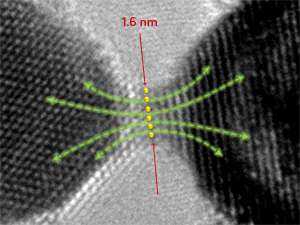Experiments on tiny gold prisms help to explain the unusual electrodynamics of nanostructures

Nanoplasmonics—the study of light manipulation on the nanometer scale—has contributed to the production of novel devices for chemical and biological sensing, signal processing and solar energy. However, components at such small scales experience strange effects that classical electrodynamics cannot explain. A particular challenge for theorists lies in isolating so-called 'nonlocal' effects, whereby the optical properties of a particle are not constant but depend on nearby electromagnetic fields.
Now, Joel Yang and colleagues at the A*STAR Institute of Materials Research and Engineering in Singapore, with co-workers in the United Kingdom and China, have used both simulations and experiments to investigate the nonlocal effects displayed by electrons in metal nanostructures.
The team developed three-dimensional simulations of electron-energy loss spectroscopy (EELS) spectra. EELS is a powerful laboratory technique that can provide information on nanostructure geometries, but also gives rise to nonlocal effects. An EELS device is used to fire energetic electrons at a metal nanostructure and then to measure how much energy the electrons lose when they excite plasmon resonances in the sample. Previously, it had been difficult for experimentalists to correctly interpret EELS spectra because the nonlocal effects are not considered in current theory—the relevant solutions of Maxwell's field equations.
Yang and co-workers present the first full three-dimensional solution of Maxwell's equations for a sample being probed by an EELS source. "Our theoretical configuration mimics the experimental setup and the equations were, for the first time, implemented and solved using commercial software," says Yang.
The researchers applied their theory to triangular gold nanoprisms and concluded that significant nonlocal effects occur when the side length of the prisms is smaller than 10–50 nanometers, causing a spatial dispersion of electromagnetic fields. They then examined real EELS results for gold 'bowtie' nanostructures—each gold bowtie was created by joining two nanoprisms at their peaks using gold bridges as narrow as 1.6 nanometers (see image).
The real bowties exhibited a similar spatial field dispersion to that anticipated for single prisms, but with greatly reduced high-frequency conduction at the narrow connective bridges. The researchers speculate that the field reduction is caused by two factors not included in their model—quantum confinement in the narrow bridges as well as electron scattering from grain boundaries. These factors help to explain the interplay between nonlocality and geometry.
"Existing models tend to treat metals as having homogeneous optical properties," says Yang. "Our results suggest that at the nanoscale we need to take account of quantum confinement and granularity."
More information: Wiener, A., Duan, H., Bosman, M., Horsfield, A. P., Pendry, J. B. et al. "Electron-energy loss study of nonlocal effects in connected plasmonic nanoprisms." ACS Nano 7, 6287–6296 (2013). dx.doi.org/10.1021/nn402323t
Journal information: ACS Nano




















